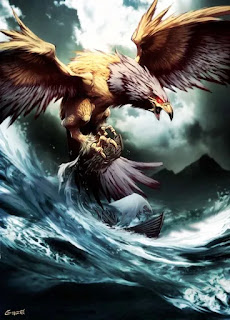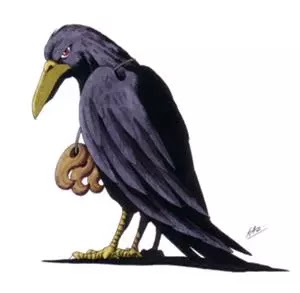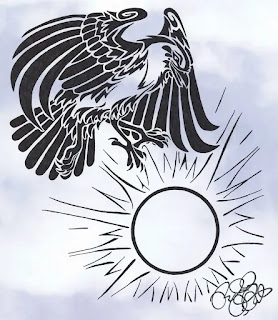1. Phoenix
Birds that live in the beliefs of the Romans, Greeks, he is described with all the beauty, elegance and strength. Based on myth, this Phoenix bird lived for 500 years. This fire bird is described as having very beautiful red and golden feathers. Phoenix is said to be able to live for 500 or 1461 years. After living that long, the Phoenix burned itself. After that, from the ashes, a young Phoenix bird appeared. The life cycle of such a Phoenix bird (regeneration), rises again after death, then appears as a new figure. Phoenix is a symbol of immortality, a symbol of the cycle of life after death, and a symbol of bodily resurrection after death.
2. Bennu
It is a bird that functions as Egyptian correspondence to Phoenix, and is said to be the soul of the Sun God Ra. Some of Bennu's nicknames are, 'He who came to be alone', 'Up One', and 'God of Jubilee'. Bennu is the common name given to birds in English, the original vowel of the name is spelled as Egyptian BNN by scribes. Bennu phoenix is Egyptian mythology. This bird is also associated with the publication of the Nile, the resurrection, and the sun.
3. Huma
The legendary bird from the Sufi fable which is said to never rest, spent its entire life flying around the earth, and never landed. There is also a legend that says he has no legs. The word huma comes from two different words, u hu ’symbolizes the soul and‘ ma ’symbolizes water. In Turkish mythology, Huma has similarities to kumay or umay birds, where umay are goddesses of fertility and virginity. In the Sufi tradition, capturing huma is an impossible thing to do. People who are able to catch huma will not survive more than forty days.
4. Garuda
This bird is also a symbol of the Republic of Indonesia. His body is golden, his face is bright white, his wings are red, has a beak like an eagle, with a crown on his head. In the Hindu religion Garuda occupies a very important position, Lord Krishna drove it to kill the figure of Narakasura. In another story Raja Hari rides Garuda to save Gayendra.
5. Fenghuang
At first Fenghuang was described as two birds where the male is called Feng and the female is called Huang. It began to appear at the beginning of the Shang dynasty (around 4,000 years ago). During the Han dynasty (2,200 years ago) these two birds were often depicted facing each other. But during the Yuan dynasty, these two figures were combined and generally referred to as Phoenix or King of the Birds. But since the time of King Jiajing (1522-1566), this bird was again made into two different figures. The males can be identified from 5/3 tail feathers (five / three ~ odd ~ which) while the females have 2 tail feathers (one ~ even ~ yin). (**)
6. Roc
Roc or Rukh (from Arabic رخ rokh) is an unusually large meat-eating bird that is capable of carrying and eating elephants. Among other legendary birds, roc is the most commonly reported bird seen in history.
One guess says, the legend of roc comes from a large eagle that is able to bring a newborn lamb. Especially after the discovery of fossil eagles originating from the genus Stephanoaetus in Madagascar.
7. Alkonost
With the body of a bird, Alkonost has a woman's head and chest. Has a name that comes from a human mythological figure half god Alcyone which was changed by the gods to become a kingfisher fish.
Alkonost reproduces by laying eggs on the edge of the beach and putting them into the water. The eggs will hatch after six to seven days and will cause a storm.
Alkonost is believed to be the will of the god, where he lives in heaven and will go down to earth to convey the message of god to humans. He has a very beautiful singing voice that signifies a bright and positive future, but everyone who hears it will forget anything at that time. Alkonost has the image of being a bird of happiness, in contrast to the bird of suffering
8. Jatayu
Jatayu (Sanskrit: जटायू ,; Jatāyū) is the protagonist of Wiracarita Ramayana, son of the Aruna and niece of the Garuda. He is a brother of Sempati. He is a bird that saw how Dewi Sita was kidnapped by Rawana. He tried to fight but lost his fight and eventually died. But when he was not dead and still dying, he could still report to Sri Rama that his wife Dewi Sita had been kidnapped.
After Jatayu breathed his last breath, Sang Rama said:
The place where Sri Rama discovered the dying Jatayu is called Jatayu Mangalam, now known as Chadaya Mangalam, located in Kollam District, Kerala. The large stone in the place is called JatayuPara, taken from the name Jatayu. The place is used as a tourist attraction.
It is believed that Jatayu is a child of Garuda and is the niece of Naga.
9. Yatagarasu
In Japanese mythology, yatagarasu (八 咫 烏, "eight-span crow") is a raven whose appearance is the embodiment of the will of heaven or the intervention of the gods in human affairs. Although there is no clear evidence, yatagarasu is believed to be the embodiment of Taketsunimi no Mikoto.
Yatagarasu is the pet of the sun god Amaterasu in ancient documents entitled Nihon Shoki (日本 書 紀) and Kojiki (古 事 記) in charge of the sun and guarding the emperor Jimmu. In his task of controlling the emperor Jimmu, yatagarasu played a key role in giving the emperor and his troops the direction of an eastward conquest expedition.
So far the number of yatagarasu feet is still controversial as some sources do not mention the number of yatagarasu feet at all.
Another controversy, there is a confusion between the yatagarasu and the golden kite. Because in the kojiki document even though yatagarasu appears in the story, it is not mentioned that he guided the emperor Jimmu but the kite.
10. Sanzuniao
In Chinese mythology there is also a story about this three-legged bird, commonly called sanzuniao (Chinese: 三 足 鳥; pinyin: sānzúniǎo). Initially mentioned in a Neolithic poem in Yangshao culture, sanzuniao also appeared in shanhaijing.
The most popular depiction and mythology of sanzuniao is the sun crow called Yangwu (Chinese: 陽 烏; pinyin: yángwū) or sometimes also called Jīnwū (Chinese: 金 烏; pinyin: jīnwū) or red golden crow.
According to folklore, there are ten sun crows, each of which keeps a sun. Each of them perched on a red mulberry tree called Fusang (Chinese: 扶桑; pinyin: fúsāng), which is under the valley east of the sun. Every day, a crow surrounds the earth driven by Xihe (mother of the sun). Each one returns, the other departs to do the same (this is the story of why the sun goes around the earth according to mythology). According to the shanhaijing fable, this crow likes to eat two grasses of immortality, one called Self (Chinese: 地 日; pinyin: dìrì), or "ground sun" and another called Chunseng (Chinese: 春 生; pinyin: chūnshēng), or "spring grow ". These sun crows like to go from earthly paradise to find and eat this grass, but Xihe doesn't like it and closes their eyes to prevent them from doing the same. But one day around 2170 BC, the ten sun ravens went to earth together and caused the entire surface of the earth to burn. A surawi archer named Houyi saved the earth by arching the nine crows and leaving only one of them (remember the story of sun-go-kong right).
11. Samjokgo
In Chinese mythology, this three-legged bird is known as Samjokgo (hangul: anja; hanja: 三 足 烏). In the period of the koguyo kingdom, samjokgo symbolizes strength and has the same position as dragons and pheonix
Can't get additional information, it's really hard to find info for this bird ...
12. Sirin
Taking a form not far from aconost, the siren is named after its mythological myth: siren. As a representation of the will of the gods and the balance of the world.
Like an alkonost, the siren is believed to have a beautiful singing voice and is capable of captivating humans. But the song can keep people from following it and will leave slowly.
13. Gamaiun / Gamayun
A heavenly bird that has a large size and is often described as white, almost resembling alkonost and sirin. Has a bird shape but with a woman's head and chest.
Having an image as a bird of wisdom and knowledge, its singing is a sign of the coming of happiness. Living far away in the eastern part of the earth, the only birds in Russian mythology that do not live in heaven but only near heaven.
Source
13 Burung Dalam Mitologi Dunia [ Serba 13 ]
Birds that live in the beliefs of the Romans, Greeks, he is described with all the beauty, elegance and strength. Based on myth, this Phoenix bird lived for 500 years. This fire bird is described as having very beautiful red and golden feathers. Phoenix is said to be able to live for 500 or 1461 years. After living that long, the Phoenix burned itself. After that, from the ashes, a young Phoenix bird appeared. The life cycle of such a Phoenix bird (regeneration), rises again after death, then appears as a new figure. Phoenix is a symbol of immortality, a symbol of the cycle of life after death, and a symbol of bodily resurrection after death.
2. Bennu
It is a bird that functions as Egyptian correspondence to Phoenix, and is said to be the soul of the Sun God Ra. Some of Bennu's nicknames are, 'He who came to be alone', 'Up One', and 'God of Jubilee'. Bennu is the common name given to birds in English, the original vowel of the name is spelled as Egyptian BNN by scribes. Bennu phoenix is Egyptian mythology. This bird is also associated with the publication of the Nile, the resurrection, and the sun.
3. Huma
The legendary bird from the Sufi fable which is said to never rest, spent its entire life flying around the earth, and never landed. There is also a legend that says he has no legs. The word huma comes from two different words, u hu ’symbolizes the soul and‘ ma ’symbolizes water. In Turkish mythology, Huma has similarities to kumay or umay birds, where umay are goddesses of fertility and virginity. In the Sufi tradition, capturing huma is an impossible thing to do. People who are able to catch huma will not survive more than forty days.
4. Garuda
This bird is also a symbol of the Republic of Indonesia. His body is golden, his face is bright white, his wings are red, has a beak like an eagle, with a crown on his head. In the Hindu religion Garuda occupies a very important position, Lord Krishna drove it to kill the figure of Narakasura. In another story Raja Hari rides Garuda to save Gayendra.
5. Fenghuang
At first Fenghuang was described as two birds where the male is called Feng and the female is called Huang. It began to appear at the beginning of the Shang dynasty (around 4,000 years ago). During the Han dynasty (2,200 years ago) these two birds were often depicted facing each other. But during the Yuan dynasty, these two figures were combined and generally referred to as Phoenix or King of the Birds. But since the time of King Jiajing (1522-1566), this bird was again made into two different figures. The males can be identified from 5/3 tail feathers (five / three ~ odd ~ which) while the females have 2 tail feathers (one ~ even ~ yin). (**)
6. Roc
Roc or Rukh (from Arabic رخ rokh) is an unusually large meat-eating bird that is capable of carrying and eating elephants. Among other legendary birds, roc is the most commonly reported bird seen in history.
One guess says, the legend of roc comes from a large eagle that is able to bring a newborn lamb. Especially after the discovery of fossil eagles originating from the genus Stephanoaetus in Madagascar.
7. Alkonost
With the body of a bird, Alkonost has a woman's head and chest. Has a name that comes from a human mythological figure half god Alcyone which was changed by the gods to become a kingfisher fish.
Alkonost reproduces by laying eggs on the edge of the beach and putting them into the water. The eggs will hatch after six to seven days and will cause a storm.
Alkonost is believed to be the will of the god, where he lives in heaven and will go down to earth to convey the message of god to humans. He has a very beautiful singing voice that signifies a bright and positive future, but everyone who hears it will forget anything at that time. Alkonost has the image of being a bird of happiness, in contrast to the bird of suffering
8. Jatayu
Jatayu (Sanskrit: जटायू ,; Jatāyū) is the protagonist of Wiracarita Ramayana, son of the Aruna and niece of the Garuda. He is a brother of Sempati. He is a bird that saw how Dewi Sita was kidnapped by Rawana. He tried to fight but lost his fight and eventually died. But when he was not dead and still dying, he could still report to Sri Rama that his wife Dewi Sita had been kidnapped.
After Jatayu breathed his last breath, Sang Rama said:
The place where Sri Rama discovered the dying Jatayu is called Jatayu Mangalam, now known as Chadaya Mangalam, located in Kollam District, Kerala. The large stone in the place is called JatayuPara, taken from the name Jatayu. The place is used as a tourist attraction.
It is believed that Jatayu is a child of Garuda and is the niece of Naga.
9. Yatagarasu
In Japanese mythology, yatagarasu (八 咫 烏, "eight-span crow") is a raven whose appearance is the embodiment of the will of heaven or the intervention of the gods in human affairs. Although there is no clear evidence, yatagarasu is believed to be the embodiment of Taketsunimi no Mikoto.
Yatagarasu is the pet of the sun god Amaterasu in ancient documents entitled Nihon Shoki (日本 書 紀) and Kojiki (古 事 記) in charge of the sun and guarding the emperor Jimmu. In his task of controlling the emperor Jimmu, yatagarasu played a key role in giving the emperor and his troops the direction of an eastward conquest expedition.
So far the number of yatagarasu feet is still controversial as some sources do not mention the number of yatagarasu feet at all.
Another controversy, there is a confusion between the yatagarasu and the golden kite. Because in the kojiki document even though yatagarasu appears in the story, it is not mentioned that he guided the emperor Jimmu but the kite.
10. Sanzuniao
In Chinese mythology there is also a story about this three-legged bird, commonly called sanzuniao (Chinese: 三 足 鳥; pinyin: sānzúniǎo). Initially mentioned in a Neolithic poem in Yangshao culture, sanzuniao also appeared in shanhaijing.
The most popular depiction and mythology of sanzuniao is the sun crow called Yangwu (Chinese: 陽 烏; pinyin: yángwū) or sometimes also called Jīnwū (Chinese: 金 烏; pinyin: jīnwū) or red golden crow.
According to folklore, there are ten sun crows, each of which keeps a sun. Each of them perched on a red mulberry tree called Fusang (Chinese: 扶桑; pinyin: fúsāng), which is under the valley east of the sun. Every day, a crow surrounds the earth driven by Xihe (mother of the sun). Each one returns, the other departs to do the same (this is the story of why the sun goes around the earth according to mythology). According to the shanhaijing fable, this crow likes to eat two grasses of immortality, one called Self (Chinese: 地 日; pinyin: dìrì), or "ground sun" and another called Chunseng (Chinese: 春 生; pinyin: chūnshēng), or "spring grow ". These sun crows like to go from earthly paradise to find and eat this grass, but Xihe doesn't like it and closes their eyes to prevent them from doing the same. But one day around 2170 BC, the ten sun ravens went to earth together and caused the entire surface of the earth to burn. A surawi archer named Houyi saved the earth by arching the nine crows and leaving only one of them (remember the story of sun-go-kong right).
11. Samjokgo
In Chinese mythology, this three-legged bird is known as Samjokgo (hangul: anja; hanja: 三 足 烏). In the period of the koguyo kingdom, samjokgo symbolizes strength and has the same position as dragons and pheonix
Can't get additional information, it's really hard to find info for this bird ...
12. Sirin
Taking a form not far from aconost, the siren is named after its mythological myth: siren. As a representation of the will of the gods and the balance of the world.
Like an alkonost, the siren is believed to have a beautiful singing voice and is capable of captivating humans. But the song can keep people from following it and will leave slowly.
13. Gamaiun / Gamayun
A heavenly bird that has a large size and is often described as white, almost resembling alkonost and sirin. Has a bird shape but with a woman's head and chest.
Having an image as a bird of wisdom and knowledge, its singing is a sign of the coming of happiness. Living far away in the eastern part of the earth, the only birds in Russian mythology that do not live in heaven but only near heaven.
Source
13 Burung Dalam Mitologi Dunia [ Serba 13 ]















إرسال تعليق